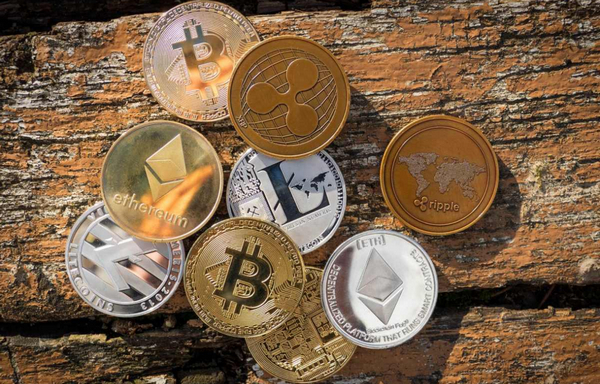Cryptocurrency Encyclopedia
Explore the future together and let everyone know the world of cryptocurrency equally!
-

- Digital currency trading profit strategy
- Sep 20,2024 at 07:48pm
Strategies for Maximizing Profits in Digital Currency Trading
Understanding the Market
Research market trends and indicators to gauge market sentiment and volatility.
Monitor news and events that could impact currency prices.
Risk Management
Determine an acceptable risk tolerance and allocate funds accordingly.
Implement stop-loss orders to limit potential losses.
Diversify portfolio with different digital assets.
Trading Techniques
Scalping:
Description: Involves executing numerous small trades based on slight price fluctuations.
Advantages: Can generate consistent profits over time, requires less capital.
Disadvantages: Requires high liquidity and precision.
Day Trading:
Description: Involves buying and selling digital currencies within the same day.
Advantages: Takes advantage of intraday price movements, can be lucrative.
Disadvantages: Requires constant monitoring, high probability of losses.
Swing Trading:
Description: Involves holding digital currencies for a few days or weeks based on technical analysis.
Advantages: Can generate substantial profits by riding market trends.
Disadvantages: Requires patience and the ability to withstand fluctuations.
Position Trading:
Description: Involves holding digital currencies for months or years based on fundamental analysis.
Advantages: Targets long-term price appreciation, low risk.
Disadvantages: Requires significant capital, slow returns.
Technical Analysis
Use technical indicators like moving averages, relative strength index (RSI), and Bollinger Bands to identify potential trading opportunities.
Study price patterns and formations to anticipate market direction.
Fundamental Analysis
Consider factors like regulation, adoption rates, development activity, and team behind a project.
Evaluate a digital currency's potential for growth and adoption.
Execution
Choose a reliable trading platform that offers low fees and high liquidity.
Place orders carefully and monitor them in real-time.
Exercise patience and discipline in executing trades.
Other Considerations
Keep a trading journal to track progress and identify patterns.
Seek professional advice if necessary.
Be aware of regulatory and tax implications of digital currency trading.
-

- Which virtual currency is the most promising to invest in
- Sep 20,2024 at 07:48pm
Promising Virtual Currency Options for Investment
Introduction
With the increasing popularity of cryptocurrency, investors are seeking promising digital currencies to invest in. This article examines some of the most promising virtual currencies to consider for investment.
Bitcoin (BTC)
Symbol: BTC
Market Cap: $314.1 billion (as of March 8, 2023)
Origin: 2008
Bitcoin remains the dominant cryptocurrency in terms of market capitalization and value. Its decentralized nature, established infrastructure, and wide acceptance make it a reliable investment option.
Ethereum (ETH)
Symbol: ETH
Market Cap: $165.7 billion (as of March 8, 2023)
Origin: 2015
Ethereum is a decentralized platform that allows developers to build decentralized applications (dApps). Its smart contract capability and growing ecosystem make it a promising choice for investment.
Binance Coin (BNB)
Symbol: BNB
Market Cap: $40.9 billion (as of March 8, 2023)
Origin: 2017
Binance Coin is the native token of the Binance cryptocurrency exchange. It offers discounted trading fees, rewards for holding, and access to exclusive features on the exchange.
Solana (SOL)
Symbol: SOL
Market Cap: $10.8 billion (as of March 8, 2023)
Origin: 2017
Solana is a high-performance blockchain that focuses on transaction speed and low fees. Its lightning-fast transaction processing makes it attractive for various decentralized applications.
Cardano (ADA)
Symbol: ADA
Market Cap: $8.5 billion (as of March 8, 2023)
Origin: 2017
Cardano is another decentralized blockchain platform that emphasizes security and scalability. Its rigorous academic approach and research-driven approach make it a promising option for investment.
Additional Factors to Consider
Market capitalization: Indicates the overall value of the cryptocurrency.
Trading volume: Reflects the liquidity of the currency.
Technology: Evaluate the underlying blockchain technology and its capabilities.
Team: Consider the experience and expertise of the development team.
Adoption rate: Assess the number of businesses and individuals using the currency.
Disclaimer
Investing in virtual currencies is subject to market risks. It is essential to do thorough research and consult financial advisors before making any investment decisions.
-

- How to invest in digital currency to make money
- Sep 20,2024 at 07:47pm
How to Invest in Digital Currency to Make Money
Digital currencies, such as Bitcoin and Ethereum, have gained immense popularity in recent years. With their decentralized nature and potential for high returns, many people are looking to invest in digital currency to make money. However, it's important to understand the risks and complexities involved in digital currency investments before you jump in.
Understanding Digital Currencies
Before investing in digital currency, it's crucial to understand what it is and how it works. Digital currencies are decentralized, meaning they are not controlled by any central authority like a bank or government. Transactions are recorded on a public ledger called a blockchain, which is verified by a distributed network of computers.
Types of Digital Currencies
There are thousands of different digital currencies available, each with its own unique characteristics. Some of the most popular include:
Bitcoin (BTC): The first and most well-known cryptocurrency.
Ethereum (ETH): A blockchain platform that supports smart contracts and decentralized applications.
Ripple (XRP): A cryptocurrency designed for cross-border transactions.
Litecoin (LTC): A faster and cheaper alternative to Bitcoin.
Benefits of Investing in Digital Currency
High potential for growth: Digital currencies have historically shown high levels of volatility, but also significant growth potential.
Decentralization: Digital currencies are not controlled by any central authority, giving investors more control over their assets.
Diversification: Investing in digital currency can diversify your investment portfolio and potentially reduce risk.
Risks of Investing in Digital Currency
Volatility: Digital currency prices can fluctuate significantly, leading to both potential gains and losses.
Regulation: The regulatory landscape for digital currencies is constantly evolving, which can create uncertainty.
Scams and fraud: There are many scams and fraudulent activities associated with digital currencies, so it's important to be vigilant.
How to Invest in Digital Currency
Choose a reputable exchange: There are many different cryptocurrency exchanges available. Choose one that is regulated, has a good reputation, and supports the digital currency you want to buy.
Create an account: Once you have chosen an exchange, create an account and verify your identity.
Fund your account: You can fund your account with fiat currency (e.g., USD, EUR) or other digital currencies.
Buy digital currency: Once your account is funded, you can place an order to buy digital currency. Specify the amount and type of digital currency you want to buy.
Store your digital currency: After purchasing your digital currency, you need to store it securely. You can use a hardware wallet, software wallet, or exchange-based wallet.
Tips for Investing in Digital Currency
Do your research: Understand the risks and potential returns before investing in any digital currency.
Invest only what you can afford to lose: Digital currencies are volatile, so only invest what you are prepared to potentially lose.
Diversify your investments: Don't put all your eggs in one basket. Invest in multiple digital currencies to reduce risk.
Be patient: Investing in digital currency is a long-term game. Don't expect to get rich quick.
Conclusion
Investing in digital currency to make money can be a lucrative endeavor, but it's important to approach it with caution. Understand the risks involved, do your research, and invest only what you can afford to lose. By following these tips, you can increase your chances of success and potentially generate substantial returns from your digital currency investments.
-

- How do ordinary people invest in virtual currency
- Sep 20,2024 at 07:46pm
How Ordinary People Can Invest in Virtual Currency
Virtual currency, also known as cryptocurrency, has gained immense popularity in recent years. While the concept of virtual currency can be complex, investing in it doesn't have to be. Here's a simplified guide for ordinary people on how to invest in virtual currency:
Understanding Virtual Currency
Before investing, it's crucial to understand what virtual currency is. Virtual currencies are digital or virtual forms of currency that use cryptography for secure transactions. They operate independently of central banks or governments. Some well-known virtual currencies include Bitcoin, Ethereum, and Litecoin.
Choosing a Platform
Once you understand virtual currency, the next step is to choose a reputable platform to trade or invest. There are many exchanges and brokers that offer virtual currency trading. Some popular options include Coinbase, Binance, and Kraken. Research and compare platforms based on their fees, security measures, and supported currencies.
Creating an Account
To invest in virtual currency, you need to create an account on your chosen platform. This typically involves providing personal information and submitting identity verification documents. Once your account is verified, you can fund your account through various methods such as bank transfers, credit cards, or other payment options.
Selecting a Currency
With your account funded, you can start selecting which virtual currencies to invest in. There are numerous options available, each with its unique characteristics and volatility. Consider factors such as market capitalization, development team, and community support when making your selections.
Placing an Order
Once you've chosen your virtual currencies, you can place an order to buy them. Platforms typically provide various order types, such as market orders (executed immediately at the best available price) or limit orders (executed when the currency reaches a specific price). Choose the order type that suits your investment strategy.
Monitoring and Managing
Investing in virtual currency requires monitoring and managing your portfolio regularly. Track the performance of your investments and adjust your strategy as needed. Pay attention to market trends, news, and developments within the virtual currency world to make informed decisions.
Tips for Beginners
Start small and gradually increase your investment as you gain experience.
Diversify your portfolio by investing in multiple virtual currencies.
Don't invest more than you can afford to lose.
Be prepared for market volatility and don't panic sell during price fluctuations.
Store your virtual currencies in a secure wallet to protect them from unauthorized access.
Investing in virtual currency can be a potentially rewarding but also risky endeavor. By following these steps and taking a prudent approach, ordinary people can navigate the world of virtual currency and potentially grow their investments.
-

- How many ways are there to invest in cryptocurrency?
- Sep 20,2024 at 07:46pm
How to Invest in Cryptocurrency: A Detailed Guide
Introduction
Cryptocurrency, a decentralized digital currency, has gained immense popularity in recent years, offering investors a wide range of investment opportunities. With its volatile nature and potential for substantial gains, understanding the various investment options is crucial for investors seeking to navigate the cryptocurrency market.
Direct Investment
1. Purchasing Cryptocurrencies on Exchanges:
Cryptocurrency exchanges such as Coinbase, Binance, and Kraken allow you to buy and sell cryptocurrencies directly.
Choose an exchange with a solid reputation, low fees, and a wide selection of coins.
Fund your exchange account using fiat currency or other cryptocurrencies.
Place buy orders for the desired cryptocurrencies.
2. Over-the-Counter (OTC) Trading:
OTC trading involves buying and selling cryptocurrencies directly with other individuals or institutions.
OTC desks at exchanges and specialized platforms offer this service for larger trades.
Negotiate the price and settlement terms before executing the trade.
Indirect Investment
1. Cryptocurrency Mining:
Mining involves verifying transactions on the blockchain network and earning cryptocurrencies as a reward.
Requires specialized hardware (e.g., ASIC miners) and a substantial upfront investment.
Mining profitability varies based on market conditions and electricity costs.
2. Cryptocurrency Lending:
Platforms like Celsius, BlockFi, and Nexo allow you to earn interest on your cryptocurrencies by lending them to borrowers.
Provides a passive income stream but comes with interest rate and market risks.
3. Cryptocurrency ETFs:
ETFs (exchange-traded funds) that track the performance of a basket of cryptocurrencies or provide exposure to the broader cryptocurrency market.
Offer portfolio diversification and ease of investment through traditional investment platforms.
4. Cryptocurrency Investment Trusts:
Closed-end investment funds that invest in cryptocurrencies.
Provide access to cryptocurrency assets through traditional brokerage accounts.
However, they may have higher fees and limited liquidity.
Other Options
1. Non-Fungible Tokens (NFTs):
NFTs are unique digital assets that represent ownership of specific items (e.g., art, music, videos).
Investing in NFTs allows participation in the growing digital art and collectibles market.
2. Initial Coin Offerings (ICOs):
ICOs are fundraising mechanisms where companies issue new cryptocurrencies or tokens.
Investors can purchase these tokens in exchange for future equity or ownership rights.
However, ICOs carry significant risks and should be approached with caution.
Conclusion
Investing in cryptocurrency offers multiple options, each with its own advantages and risks. By understanding these methods, investors can tailor their strategies based on their investment goals, risk tolerance, and market knowledge. It's essential to conduct thorough research, diversify your portfolio, and consider the volatility and regulatory landscape before investing in cryptocurrency.
-

- How to get cryptocurrency?
- Sep 20,2024 at 07:44pm
How to Get Cryptocurrency
Cryptocurrency has become an increasingly popular investment and payment method, and there are several ways to get your hands on some. Here's a comprehensive guide to help you navigate the process:
1. Purchase on Exchanges
The most common way to obtain cryptocurrency is through cryptocurrency exchanges. These platforms allow you to buy and sell cryptocurrencies using various payment methods, including credit cards, bank transfers, and mobile payment apps.
Top Cryptocurrency Exchanges:
Binance
Coinbase
FTX
Kraken
Gemini
2. Crypto ATMs
Crypto ATMs are physical kiosks where you can buy and sell cryptocurrency with cash. These machines are becoming more prevalent in major cities and offer a convenient way to get crypto without needing to register on an exchange.
3. Mining
Mining is the process of using specialized computers to solve complex mathematical equations to validate cryptocurrency transactions. This process rewards the miner with newly created cryptocurrency. However, mining requires specialized equipment and technical expertise, making it less accessible for beginners.
4. Cloud Mining
Cloud mining allows you to rent computing power from professional mining companies. You can purchase contracts to participate in mining operations without the need for physical equipment. This method requires less technical expertise than traditional mining but may involve fees.
5. Faucets
Cryptocurrency faucets are websites or apps that reward users with small amounts of cryptocurrency for completing tasks such as watching ads, taking surveys, or playing games. While not a significant source of income, faucets can provide a small amount of crypto to get started.
6. Airdrops
Airdrops are promotional campaigns where cryptocurrency projects distribute free tokens to potential users. These tokens are often given as rewards for referring new users or participating in particular events on the project's platform.
7. Investing in Crypto-Related Stocks
Investing in companies that develop or operate cryptocurrency platforms, wallets, or services can provide indirect exposure to the cryptocurrency market. Investors can purchase shares of these companies on traditional stock exchanges.
8. Cryptocurrency Rewards Programs
Some companies and organizations offer rewards in cryptocurrency for making purchases or using their services. These programs can be a passive way to accumulate crypto over time.
It's important to note that the value of cryptocurrency can fluctuate significantly, and there is always a risk of losing your investment. As with any investment, it's crucial to research thoroughly, understand the risks involved, and invest only what you can afford to lose.
-

- How to choose cryptocurrency?
- Sep 20,2024 at 07:44pm
How to Choose the Right Cryptocurrency for Your Needs
With over 20,000 cryptocurrencies available, choosing the right one can be a daunting task. Here is a comprehensive guide to help you navigate the crypto market and make an informed decision:
1. Determine Your Objectives:
Before choosing a cryptocurrency, ask yourself these questions:
Short-term vs. long-term: Are you looking to trade or invest for the long term?
Risk tolerance: How comfortable are you with volatility and potential losses?
Use case: What purpose will you use the cryptocurrency for, such as payments, investment, or DeFi?
2. Research Different Cryptocurrencies:
Familiarize yourself with the different cryptocurrencies available by reading their whitepapers and researching their:
Technology: Understand the underlying blockchain, consensus mechanism, and scalability.
Use cases: Explore the specific applications of the cryptocurrency, such as payments, smart contracts, or store of value.
Community: Assess the size, activity, and support of the project's community.
3. Consider Market Capitalization and Trading Volume:
Market capitalization (the total value of a coin or token in circulation) and trading volume provide insights into:
Popularity: High market cap and volume indicate widespread adoption and demand.
Liquidity: Active trading ensures easy buying and selling of the cryptocurrency.
4. Evaluate Security and Risk:
Security: Look for cryptocurrencies that prioritize security measures, such as multi-signature vaults, cold storage, and regular vulnerability assessments.
Risk: Consider factors like the project's age, team experience, and past performance to assess the inherent risk involved.
5. Consider Use Cases and Ecosystem:
Use cases: Choose a cryptocurrency that aligns with your intended use cases. For example, if you need a secure payment system, consider a cryptocurrency with fast transaction speeds and low fees.
Ecosystem: Assess the availability of wallets, exchanges, and other applications that support the cryptocurrency to ensure ease of usage and accessibility.
6. Rankings and Lists:
Various reputable websites and analysts provide rankings of cryptocurrencies based on factors like market cap, trading volume, and blockchain technology:
CoinMarketCap
CoinGecko
Forbes
Weiss Ratings
These rankings can serve as a reference point, but it's crucial to conduct your own research before making a decision.
7. Seek Professional Advice:
If you lack the time or expertise to conduct thorough research, consider consulting a financial advisor or cryptocurrency expert who can provide personalized guidance based on your individual circumstances and goals.
Conclusion:
Choosing the right cryptocurrency requires a combination of research, evaluation, and careful consideration. By following these steps and staying informed about the cryptocurrency market, you can navigate the complex landscape and select the cryptocurrency that best meets your specific needs.
-

- How to invest in cryptocurrency?
- Sep 20,2024 at 07:42pm
How to Invest in Cryptocurrency
1. Understand the Basics
Before investing in cryptocurrency, it's crucial to grasp the fundamental concepts:
What is cryptocurrency? Digital or virtual currencies using encryption for security and transaction verification.
Types of cryptocurrencies: Bitcoin, Ethereum, Dogecoin, etc., with different characteristics and uses.
Blockchain: A decentralized technology that records transactions securely and transparently.
2. Choose a Cryptocurrency Exchange
Centralized exchanges: Regulated platforms where users can buy and sell cryptocurrencies directly. Examples: Coinbase, Binance.
Decentralized exchanges: Peer-to-peer marketplaces where users trade crypto directly without intermediaries. Examples: Uniswap, PancakeSwap.
3. Create an Account and Fund it
Register with the chosen exchange and complete the verification process.
Fund your account using a bank transfer, credit card, or other supported payment methods.
4. Research and Select Cryptocurrencies
Analyze market trends, news, and project whitepapers to identify potential investments.
Consider factors such as the project's technology, team, and community.
Diversify your portfolio by investing in different cryptocurrencies with varying risk levels.
5. Buy Cryptocurrency
Use the exchange's interface to place an order for the desired cryptocurrency.
Choose the order type (e.g., market order, limit order) and specify the amount you want to buy.
6. Store Your Crypto
Software wallets: Desktop or mobile applications that store cryptocurrencies securely on your device.
Hardware wallets: Physical devices that provide cold storage and enhanced security for your crypto.
7. Manage Your Investments
Monitor your investments regularly and adjust your portfolio as needed.
Consider trading or selling cryptocurrencies to maximize returns or minimize losses.
Stay informed about industry news and regulatory changes that may impact your investments.
Additional Tips
Start small: Invest an amount you can afford to lose.
Only invest in projects you understand: Do your own research and avoid investing in anything you don't fully comprehend.
Use cold storage for long-term investments: Hardware wallets offer the highest level of security for storing your crypto offline.
Be patient: Investing in cryptocurrency requires time and persistence. Avoid panic selling or making impulsive decisions based on market fluctuations.
Consult financial professionals: Consider seeking guidance from a financial advisor specializing in cryptocurrency to make well-informed investment decisions.
-

- How to buy cryptocurrency?
- Sep 20,2024 at 07:42pm
How to Buy Cryptocurrency
Step 1: Choose a Cryptocurrency Exchange
Binance: Largest crypto exchange with wide coin selection
Coinbase: User-friendly platform with simplified purchasing options
Kraken: Reputable exchange with advanced trading features
Step 2: Create an Account
Visit the exchange's website and click on the "Sign Up" button.
Provide your personal details, such as name, email, and password.
Complete the verification process to confirm your identity.
Step 3: Fund Your Account
Link your bank account or credit/debit card to the exchange.
Choose the deposit method and enter the amount you want to deposit.
Confirm the transaction and wait for the funds to appear in your exchange account.
Step 4: Select a Cryptocurrency
Browse the available cryptocurrencies at the exchange.
Research potential coins based on factors such as market capitalization, trading volume, or use cases.
Step 5: Place an Order
Select the desired cryptocurrency and enter the amount you want to buy.
Choose the type of order, such as market order (immediate execution) or limit order (specific price point).
Click on the "Buy" button to execute the order.
Step 6: Store Your Cryptocurrency
Keep your cryptocurrency in the exchange's wallet for immediate trading or transfer it to a personal hardware wallet for enhanced security.
Use a reputable hardware wallet from brands like Ledger or Trezor.
Additional Tips:
Start with a small amount of money until you become comfortable with trading.
Diversify your portfolio across different cryptocurrencies to mitigate risks.
Store your cryptocurrency securely and don't share your private keys with anyone.
Monitor market trends and stay informed about cryptocurrency news and developments.
-

- What is cryptocurrency?
- Sep 20,2024 at 07:41pm
What is Cryptocurrency?
Definition
Cryptocurrency is a digital or virtual currency that uses cryptography for:
Security: Verifying transactions and controlling the creation of new units.
Decentralization: Operating independently of central banks or government control.
Characteristics of Cryptocurrency
Digital: Exists only in digital form, not as physical coins or notes.
Peer-to-Peer: Transactions occur directly between parties without intermediaries.
Immutable: Transaction records are stored on a distributed ledger (blockchain) and are virtually tamper-proof.
Pseudonymous: Users can transact anonymously, but transactions are publicly viewable.
Scarce: Some cryptocurrencies have a limited supply, similar to gold.
Types of Cryptocurrency
There are thousands of cryptocurrencies in existence, including:
Bitcoin (BTC): The first and most widely known cryptocurrency, created in 2009.
Ethereum (ETH): A platform that supports smart contracts and decentralized applications.
Tether (USDT): A stablecoin pegged to the U.S. dollar.
Binance Coin (BNB): The native token of the Binance cryptocurrency exchange.
XRP (XRP): A payment-focused cryptocurrency developed by Ripple Labs.
Pros of Cryptocurrency
Security: Cryptographic protocols ensure the integrity of transactions.
Decentralization: Removes control from centralized authorities.
Anonymity: Transactions are pseudonymous, providing privacy to users.
Global reach: Cryptocurrencies can be sent and received worldwide.
Scarcity: Some cryptocurrencies have a fixed supply, potentially increasing their value.
Cons of Cryptocurrency
Volatility: Cryptocurrency prices can fluctuate drastically.
Security risks: Cryptocurrencies are vulnerable to hacks and scams.
Lack of regulation: The cryptocurrency industry is largely unregulated, posing risks to investors.
Transaction fees: Can be high, especially during peak hours.
Energy consumption: Proof-of-work cryptocurrencies like Bitcoin require significant energy.
Use Cases of Cryptocurrency
Cryptocurrencies are used for a variety of purposes, including:
Payments: Sending and receiving money domestically and internationally.
Investment: Investing in cryptocurrencies with the potential for capital gains.
Smart contracts: Automating agreements and eliminating the need for intermediaries.
Non-fungible tokens (NFTs): Creating unique digital assets for ownership and authentication.
Decentralized finance (DeFi): Facilitating financial services without traditional banking institutions.
-

- What is virtual currency contract
- Sep 20,2024 at 07:31pm
What is Virtual Currency Contract?
A virtual currency contract is an agreement between two parties where one party agrees to deliver a certain amount of virtual currency to the other party in exchange for a payment in legal tender or another virtual currency.
Virtual currency contracts are often used by investors to speculate on the price of virtual currencies, such as Bitcoin and Ethereum. They can also be used by businesses to accept payments for goods and services in virtual currencies.
How Virtual Currency Contracts Work
Virtual currency contracts work in a similar way to traditional currency contracts. The buyer of the contract agrees to pay a certain price for a certain amount of virtual currency, while the seller of the contract agrees to deliver the virtual currency at a later date.
The price of virtual currency contracts is determined by the supply and demand for the underlying virtual currency. When demand for a virtual currency increases, the price of the contracts will also increase. Conversely, when demand for a virtual currency decreases, the price of the contracts will also decrease.
Risks of Virtual Currency Contracts
Virtual currency contracts involve a number of risks, including:
Price volatility: The price of virtual currencies can be highly volatile, which means that the value of your contract can fluctuate significantly in a short period of time.
Lack of regulation: Virtual currencies are not regulated by any government agency, which means that there is no guarantee that you will receive the virtual currency that you paid for.
Scams: There are a number of scams that involve virtual currency contracts. Be sure to do your research before signing any contract and only deal with reputable parties.
Conclusion
Virtual currency contracts can be a risky but potentially lucrative investment. Before you invest in any virtual currency contract, be sure to understand the risks involved and be prepared to lose your investment.
-

- How to play virtual currency contract
- Sep 20,2024 at 07:30pm
How to Play Virtual Currency Contracts
Understanding Virtual Currency Contracts
Virtual currency contracts are financial derivatives that allow traders to speculate on the price movements of digital currencies like Bitcoin or Ethereum. These contracts are typically traded on futures exchanges and are settled in either the underlying currency or cash.
Types of Virtual Currency Contracts
Futures Contracts: These contracts specify a price and date for the future delivery of a specific amount of virtual currency.
Options Contracts: These contracts give the holder the right, but not the obligation, to buy or sell a certain amount of virtual currency at a fixed price on or before a set date.
Benefits of Virtual Currency Contracts
Leverage: Traders can use leverage to magnify their profits, but also their losses.
Liquidity: These contracts offer high liquidity, allowing for quick and easy execution of trades.
Price Discovery: They help establish fair market prices for virtual currencies.
How to Play Virtual Currency Contracts
Step 1: Choose a Trading Platform
Select a reputable futures exchange that offers virtual currency contracts. Consider factors such as trading fees, liquidity, and customer support.
Step 2: Fund Your Account
Deposit funds into your trading account in a currency supported by the exchange, such as USD or BTC.
Step 3: Place an Order
Determine the type of contract you want to trade (futures or options) and specify the contract size, strike price (for options), and leverage (optional).
Step 4: Monitor Your Position
Once you place an order, monitor the price of the virtual currency. Consider using stop-loss orders to limit potential losses.
Step 5: Close Your Position
When you're ready to exit the trade, you can close your position by placing a corresponding order. The profit or loss will be credited to your account.
Tips for Playing Virtual Currency Contracts
Understand the Risks: Virtual currency markets are volatile, and leverage can magnify both profits and losses.
Do Your Research: Analyze market trends and trading strategies before making trades.
Set Stop-Loss Orders: Protect your capital by setting stop-loss orders to limit potential losses.
Manage Your Leverage: Use leverage cautiously, as it can lead to significant gains but also to sizable losses.
Monitor Market News: Stay informed about events and news that may affect the price of virtual currencies.
-

- What is cryptocurrency CFD?
- Sep 20,2024 at 07:30pm
What is Cryptocurrency CFD?
CFD (Contract for Difference) is a financial derivative instrument that allows traders to speculate on the price of an underlying asset without owning the asset itself. Cryptocurrency CFDs are CFDs that are based on the prices of cryptocurrencies, such as Bitcoin, Ethereum, and Litecoin.
CFD traders do not actually own the underlying cryptocurrency when they trade a CFD. Instead, they enter into a contract with a broker to exchange the difference between the opening and closing price of the CFD. If the price of the cryptocurrency goes up, the trader will make a profit. If the price of the cryptocurrency goes down, the trader will incur a loss.
CFD trading can be both short-term and long-term. Short-term traders use CFDs to speculate on the short-term price movements of a cryptocurrency. Long-term traders use CFDs to hedge against risk or to take a longer-term view on the price of a cryptocurrency.
There are many benefits to trading cryptocurrency CFDs, including:
Leverage: CFDs allow traders to use leverage to trade larger positions than they would be able to if they were trading the underlying cryptocurrency. This can increase the potential profits, but it can also increase the potential losses.
Short-selling: CFDs allow traders to short-sell a cryptocurrency, which means that they can profit if the price of the cryptocurrency goes down. This is in contrast to trading the underlying cryptocurrency, which can only be bought and sold.
No expiration date: CFDs do not have an expiration date, which means that traders can hold a position for as long or as short as they like.
However, there are also some risks to trading cryptocurrency CFDs:
Volatility: Cryptocurrencies can be very volatile, which means that the price can fluctuate rapidly. This can make it difficult to trade CFDs on cryptocurrencies, and it can lead to the value of a position changing quickly.
Liquidity: Cryptocurrencies can be less liquid than other assets, which means that it can be difficult to open or close a CFD trade quickly. This can lead to missed opportunities or losses if the price of the cryptocurrency moves too quickly.
Leverage risk: Using leverage to trade CFDs can increase the potential profits, but it can also increase the potential losses. Traders should only use leverage if they are aware of the risks and are prepared to lose money.
Overall, CFDs are a versatile financial instrument that can be used to speculate on the price of cryptocurrencies. However, it is important to understand the risks involved before trading CFDs on cryptocurrencies.
-

- Does cryptocurrency have contract trading?
- Sep 20,2024 at 07:29pm
Does Cryptocurrency Have Contract Trading?
Yes, cryptocurrency contract trading allows traders to speculate on the future price movements of cryptocurrencies without owning the underlying assets. This is done through financial instruments known as cryptocurrency contracts.
Types of Cryptocurrency Contracts:
1. Futures:
Standardized agreements to buy or sell a specific amount of cryptocurrency at a predetermined price on a future date.
Allow traders to speculate on future price movements and hedge against risk.
2. Options:
Contracts that give the holder the right, but not the obligation, to buy (call option) or sell (put option) a specific amount of cryptocurrency at a predetermined price on or before a certain date.
Provide higher flexibility for traders with varying market expectations.
Benefits of Cryptocurrency Contract Trading:
Leverage: Crypto contracts allow traders to leverage their positions, enabling them to potentially multiply their profits. However, it also increases risk.
Flexibility: Traders can choose contract sizes and expirations to meet their individual trading strategies.
Liquidity: Crypto contract markets usually offer higher liquidity than spot markets, which facilitates faster and smoother trading.
Volatility: The inherent volatility of cryptocurrencies can lead to significant profit potential for contract traders.
Risks of Cryptocurrency Contract Trading:
High Volatility: The volatile nature of cryptocurrencies can result in substantial losses for traders.
Leverage Risk: Leverage can lead to exaggerated losses if market movements go against the trader's position.
Margin Requirements: Contract trading involves maintaining a certain amount of margin, or collateral, which can be subject to volatility and margin calls.
Regulatory Uncertainty: The regulatory landscape for cryptocurrency contracts is still evolving, introducing uncertainty for traders.
Exchanges for Cryptocurrency Contract Trading:
Several exchanges offer cryptocurrency contract trading, including:
Binance
OKX
FTX
Bybit
Deribit
Conclusion:
Cryptocurrency contract trading offers alternative trading strategies with potential benefits and risks. Traders must carefully consider their risk tolerance and market knowledge before engaging in contract trading.
-

- What is currency contract trading?
- Sep 20,2024 at 07:26pm
Currency Contract Trading: A Guide to Spot and Futures Forex Markets
Currency contract trading involves speculating on the exchange rate fluctuations between two currencies. It is a decentralized global market that offers traders opportunities to profit from the constant demand and supply dynamics.
Types of Currency Contracts
There are two primary types of currency contracts in the forex market:
Spot Contracts: These contracts obligate the immediate exchange of the agreed-upon currencies at the current spot market price. Spot prices reflect the prevailing supply and demand and are typically used for short-term trading.
Futures Contracts: Futures contracts are standardized agreements to exchange a specified amount of currency at a predetermined price on a future date. They are used to hedge against exchange rate risk or speculate on long-term market movements.
How Currency Contract Trading Works
Currency contract trading involves the following steps:
Open an Account: Traders must open an account with a foreign exchange (forex) broker.
Fund the Account: Traders must deposit funds into their trading account.
Select a Currency Pair: Traders choose a currency pair to trade, such as EUR/USD (Euro vs. US Dollar).
Establish Position: Traders decide whether to buy or sell (go long or short) on the currency pair, based on market analysis and speculation.
Exit Position: Traders close their position by reversing their original transaction (buying or selling).
Advantages of Currency Contract Trading
High Liquidity: Forex is one of the most liquid markets globally, making it easy for traders to enter and exit positions.
24/7 Trading: The forex market operates 24 hours a day, 5 days a week, allowing for flexible trading times.
Leverage: Forex brokers provide traders with leverage, enabling them to trade with funds greater than their account balance.
Low Transaction Costs: Compared to other financial markets, currency contract trading has relatively low transaction costs.
Risks of Currency Contract Trading
Volatility: Exchange rates can fluctuate rapidly, leading to potential losses if market predictions are incorrect.
Leverage Risk: While leverage can amplify profits, it can also exacerbate losses.
Counterparty Risk: Traders must ensure the reliability and solvency of their forex broker.
FX Market Manipulation: Central banks and large financial institutions can influence exchange rates, potentially disrupting market conditions.
Political and Economic Events: Geopolitical events, interest rate changes, and economic data can significantly impact currency exchange rates.
-

- What does cryptocurrency contract mean
- Sep 20,2024 at 07:26pm
What is Cryptocurrency Contract?
A cryptocurrency contract is a financial derivative that allows traders to speculate on the price of a cryptocurrency without having to own the underlying asset. It is a binding agreement between two parties to buy or sell a specific amount of cryptocurrency at a predetermined price on a specific date in the future.
Types of Cryptocurrency Contracts:
Futures Contracts: These are standardized contracts that obligate the buyer to purchase a specified amount of cryptocurrency at a fixed price on a future date, regardless of the spot market price.
Options Contracts: These give the buyer the right, but not the obligation, to buy (call option) or sell (put option) a specified amount of cryptocurrency at a predetermined price on a specific date.
Swaps: These are bilateral agreements to exchange one cryptocurrency for another at a predetermined rate over a set period.
Key Features of Cryptocurrency Contracts:
Leverage: Contracts allow traders to gain exposure to cryptocurrency markets with just a fraction of the capital required to purchase the underlying asset. This provides potential for greater returns, but also for increased losses.
Hedging: Contracts can be used to hedge against price fluctuations and manage risk.
Trading Flexibility: Contracts offer greater flexibility than buying and holding cryptocurrency directly, as they allow traders to take both long and short positions and to profit from both rising and falling prices.
Benefits of Cryptocurrency Contracts:
Lower Investment: Contracts require less capital than direct cryptocurrency purchases.
Reduced Risk: Contracts allow traders to mitigate risk through hedging strategies.
Potential for Higher Profits: Leverage can lead to potentially higher returns, although it also comes with higher risks.
Increased Liquidity: Contracts provide increased liquidity for cryptocurrency markets by enabling more efficient trading.
Risks of Cryptocurrency Contracts:
High Volatility: Cryptocurrency markets are highly volatile, which can lead to significant losses.
Leverage Risk: The use of leverage can amplify both profits and losses.
Market Manipulation: Cryptocurrency markets are susceptible to manipulation, which can affect contract prices.
Regulation: Regulation of cryptocurrency contracts is still evolving, which can create uncertainty for traders.
-

- What is cryptocurrency contract trading
- Sep 20,2024 at 07:24pm
What is Cryptocurrency Contract Trading?
Introduction
Cryptocurrency contract trading is a derivative financial instrument that allows traders to speculate on the price movements of cryptocurrencies without actually owning the underlying asset. It involves entering into a contract with a counterparty, usually a cryptocurrency exchange or broker, to buy or sell a specific amount of cryptocurrency at a predetermined price and date.
Operation
In cryptocurrency contract trading, traders buy or sell contracts representing a specific cryptocurrency, such as Bitcoin or Ethereum. The contracts have a set expiration date and a predefined price (known as the strike price). Traders can take either a long or short position in the contract, depending on their market outlook.
Key Features
Leverage: Allows traders to amplify their gains (or losses) by using borrowed funds.
Two-way market: Traders can profit from both price increases and decreases.
No ownership: Traders do not need to physically own the cryptocurrency to participate in the market.
Quick execution: Contract trades are often executed instantly, providing traders with rapid entry and exit points.
Types of Cryptocurrency Contract Trading
Futures Contracts: Contracts that obligate traders to buy or sell a specific amount of cryptocurrency at a predetermined price on a specific future date.
Options Contracts: Contracts that give traders the option to buy or sell a specific amount of cryptocurrency at a predetermined price before a specific date.
Perpetual Swaps: Similar to futures contracts, but without a fixed expiration date. They provide traders with ongoing exposure to the underlying asset.
Benefits
Hedging: Allows traders to protect their existing cryptocurrency investments against unfavorable price movements.
Profiting from volatility: Traders can benefit from fluctuating cryptocurrency prices by taking calculated positions.
Increased flexibility: Contracts provide traders with more flexibility than directly owning cryptocurrencies, as they can easily change their positions based on market conditions.
Risks
High volatility: Cryptocurrency prices can fluctuate rapidly, leading to significant losses for leveraged traders.
Counterparty risk: The reliability of the counterparty (i.e., the exchange or broker) is crucial, as traders are exposed to their financial stability.
Liquidation: Leverage can lead to automatic liquidation of positions if the market moves against the trader's favor and their margin requirements are not met.
Factors to Consider
Risk tolerance: Traders should trade according to their risk tolerance and available capital.
Market volatility: Understand the potential risks associated with high volatility in the cryptocurrency market.
Counterparty choice: Carefully select reputable and well-established exchanges or brokers to minimize counterparty risk.
Trading strategy: Develop a sound trading strategy that aligns with your market outlook and risk tolerance.
Conclusion
Cryptocurrency contract trading offers traders a powerful tool to speculate on and hedge against price movements in the cryptocurrency market. However, it is essential to carefully understand the risks involved and trade cautiously, considering your risk tolerance and market conditions.
-

- What does cryptocurrency mining mean
- Sep 18,2024 at 07:01pm
What is Cryptocurrency Mining?
Cryptocurrency mining refers to the process of verifying and adding new transaction records to the blockchain, which is a shared and immutable ledger used to record cryptocurrency transactions. The miners who perform this task are rewarded with cryptocurrencies for their efforts.
How Does Cryptocurrency Mining Work?
Solving Complex Algorithms: Miners use specialized hardware or powerful computers to solve complex mathematical algorithms.
Verifying Transactions: Once a miner solves an algorithm, they receive a block of transactions that they have verified.
Adding to the Blockchain: The verified block is then added to the blockchain, creating a permanent and transparent record of the transactions it contains.
Rewarding Miners: As compensation for their work, miners receive a predetermined amount of cryptocurrency.
Benefits of Cryptocurrency Mining
Blockchain Security: Mining helps secure the blockchain by making it more computationally difficult for malicious actors to alter transaction records.
Decentralization: Mining contributes to the decentralized nature of cryptocurrencies by distributing the validation process among many participants.
Token Distribution: Miners play a crucial role in the distribution of new cryptocurrencies, as they are rewarded for verifying transactions.
Risks of Cryptocurrency Mining
Hardware Costs: Mining requires specialized equipment that can be expensive to purchase and maintain.
Energy Consumption: Mining processes can consume significant amounts of electricity, raising concerns about environmental impact.
Complexity: Mining requires technical knowledge and constant upkeep to ensure optimal performance.
Alternatives to Cryptocurrency Mining
In addition to mining, there are other ways to participate in the cryptocurrency ecosystem:
Trading and Investing: Individuals can buy and sell cryptocurrencies on exchanges without directly mining them.
Staking: Certain cryptocurrencies offer rewards for owners who hold their coins in a digital wallet, contributing to the security of the network.
Cloud Mining: This option allows individuals to rent mining equipment from specialized providers, reducing upfront hardware costs.
Conclusion
Cryptocurrency mining plays a vital role in the functioning of blockchain-based systems. While it offers benefits such as security and decentralization, it also comes with risks and challenges. Individuals should carefully consider the potential rewards and drawbacks before deciding whether to engage in mining.
-

- Is there a risk in mining?
- Sep 18,2024 at 07:00pm
there are risks associated with mining.
Physical risks: Mining operations can be dangerous, and miners can be injured or killed in accidents. These risks include:
Cave-ins
Explosions
Toxic fumes
Radiation
Environmental risks: Mining can damage the environment, and miners can release harmful chemicals and pollutants into the air, water, and soil. These risks include:
Water pollution
Air pollution
Land pollution
Financial risks: Mining can be a risky investment, and miners can lose money if the price of the minerals they are mining falls. These risks include:
Changes in the price of minerals
Fluctuations in the demand for minerals
Geological problems
-

- An article that details the principles of mining
- Sep 18,2024 at 06:59pm
Principles of Mining
Mining is the process of extracting valuable minerals or other geological materials from the earth. It can be a complex and challenging process, but it is also essential for obtaining the raw materials that we need to build our world.
There are many different types of mining, but all of them share some basic principles. These principles include:
Exploration: The first step in mining is exploration. This involves searching for deposits of valuable minerals or other geological materials. Exploration can be done using a variety of methods, including geological mapping, geochemical sampling, and geophysical surveys.
Extraction: Once a deposit has been found, the next step is to extract the minerals or other geological materials. This can be done using a variety of methods, including open-pit mining, underground mining, and solution mining.
Processing: Once the minerals or other geological materials have been extracted, they need to be processed to remove impurities and make them useful for their intended purpose. Processing can involve a variety of steps, including crushing, grinding, and separation.
Reclamation: Mining can have a significant impact on the environment, so it is important to reclaim the land after mining has been completed. Reclamation can involve a variety of activities, including replanting vegetation, restoring wildlife habitat, and treating contaminated water.
Mining is a complex and challenging process, but it is also essential for obtaining the raw materials that we need to build our world. By understanding the principles of mining, we can help to ensure that mining is done in a responsible and sustainable way.
Detailed Explanation of the Principles of Mining
Exploration
Exploration is the first step in mining. It involves searching for deposits of valuable minerals or other geological materials. Exploration can be done using a variety of methods, including:
Geological mapping: Geological mapping is the process of creating a map of the surface of the earth. Geological maps show the different types of rocks and minerals that are present in an area, and they can help to identify areas that are likely to contain valuable mineral deposits.
Geochemical sampling: Geochemical sampling is the process of collecting and analyzing samples of rocks and soils to determine their chemical composition. Geochemical sampling can help to identify areas that are enriched in valuable minerals, and it can also help to determine the extent of a mineral deposit.
Geophysical surveys: Geophysical surveys use instruments to measure the physical properties of the earth. Geophysical surveys can help to identify areas that are likely to contain valuable mineral deposits, and they can also help to determine the depth and extent of a mineral deposit.
Extraction
Once a deposit has been found, the next step is to extract the minerals or other geological materials. This can be done using a variety of methods, including:
Open-pit mining: Open-pit mining is a method of mining in which a large open pit is excavated to expose the mineral deposit. Open-pit mining is the most common method of mining for large deposits of minerals, such as coal and copper.
Underground mining: Underground mining is a method of mining in which a shaft or tunnel is excavated to reach the mineral deposit. Underground mining is used for mining deposits that are located deep underground, such as gold and diamonds.
Solution mining: Solution mining is a method of mining in which a solvent is used to dissolve the mineral deposit and then extract the dissolved minerals from the solution. Solution mining is used for mining deposits that are located in solution, such as uranium and salt.
Processing
Once the minerals or other geological materials have been extracted, they need to be processed to remove impurities and make them useful for their intended purpose. Processing can involve a variety of steps, including:
Crushing: Crushing is the process of breaking down large rocks or ores into smaller pieces. Crushing can be done using a variety of equipment, including jaw crushers, cone crushers, and impact crushers.
Grinding: Grinding is the process of reducing the size of crushed rocks or ores into a fine powder. Grinding can be done using a variety of equipment, including ball mills, rod mills, and SAG mills.
Separation: Separation is the process of separating the valuable minerals from the waste rock or ore. Separation can be done using a variety of methods, including gravity separation, magnetic separation, and flotation.
Reclamation
Mining can have a significant impact on the environment, so it is important to reclaim the land after mining has been completed. Reclamation can involve a variety of activities, including:
Replanting vegetation: Replanting vegetation is the process of restoring vegetation to the land after mining has been completed. Replanting vegetation can help to stabilize the soil, prevent erosion, and provide habitat for wildlife.
Restoring wildlife habitat: Restoring wildlife habitat is the process of creating or improving habitat for wildlife on land that has been mined. Restoring wildlife habitat can involve a variety of activities, such as creating nesting boxes, planting native plants, and establishing wildlife corridors.
Treating contaminated water: Treating contaminated water is the process of removing pollutants from water that has been contaminated by mining.
-
Jupiter Exchange Acquires Coinhall and SolanaFM to Solidify Position in the Solana Landscape
- Sep 20,2024 at 06:03pm
-
Santiment: Whale trades surged for these 3 altcoins!
- Sep 20,2024 at 06:02pm
-
Next Cryptocurrency To Explode: Today's article discusses the performance of potentially explosive cryptos that investors should add to their watchlist.
- Sep 20,2024 at 06:01pm
-
Bitcoin Core Developers Issue New High Severity Warning About Software Bug on 1 in 6 Bitcoin Nodes
- Sep 20,2024 at 06:01pm
-
Fantom (FTM), Bitcoin Cash (BCH), and FXGuys ($FXG) About To Take Over Amid Bullish Predictions Towards 2025
- Sep 20,2024 at 06:00pm
-
Binance Coin (BNB) and Ripple (XRP) Show Bullish Strength, But Savvy Investors Are Flocking to Rollblock’s Presale
- Sep 20,2024 at 05:57pm

















































